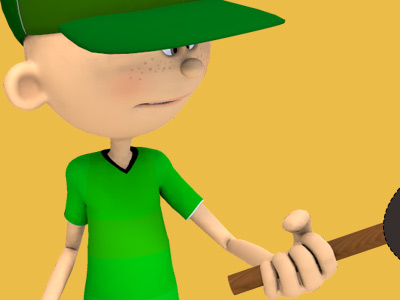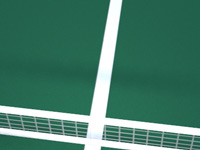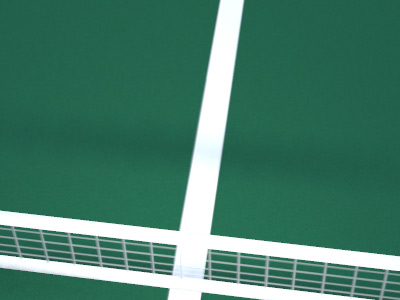Tennis

Manner of Play
Court
Tennis is played on a rectangular, flat surface. The court is 78 feet (23.77 m) long, and 27 feet (8.2 m) wide for singles matches and 36 ft (11 m) for doubles matches. Additional clear space around the court is required in order for players to reach overrun balls. A net is stretched across the full width of the court, parallel with the baselines, dividing it into two equal ends. It is held up by either a metal cable or cord that can be no more than 0.8 cm (1⁄3 in). The net is 3 feet 6 inches (1.07 m) high at the posts and 3 feet (0.91 m) high in the center. The net posts are 3 feet (0.91 m) outside the doubles court on each side or, for a singles net, 3 feet (0.91 m) outside the singles court on each side.
Tennis is unusual in that it is played on a variety of surfaces. Grass, clay, and hardcourts of concrete or asphalt topped with acrylic are the most common. Occasionally carpet is used for indoor play, with hardwood flooring having been historically used. Artificial turf courts can also be found.
Lines
The lines that delineate the width of the court are called the baseline (farthest back) and the service line (middle of the court). The short mark in the center of each baseline is referred to as either the hash mark or the center mark. The outermost lines that make up the length are called the doubles sidelines. These are the boundaries used when doubles is being played. The lines to the inside of the doubles sidelines are the singles sidelines and are used as boundaries in singles play. The area between a doubles sideline and the nearest singles sideline is called the doubles alley, which is considered playable in doubles play. The line that runs across the center of a player's side of the court is called the service line because the serve must be delivered into the area between the service line and the net on the receiving side. Despite its name, this is not where a player legally stands when making a serve.
The line dividing the service line in two is called the center line or center service line. The boxes this center line creates are called the service boxes; depending on a player's position, he or she will have to hit the ball into one of these when serving. A ball is out only if none of it has hit the line or the area inside the lines upon its first bounce. All the lines are required to be between 1 and 2 inches (25 and 51 mm) in width. The baseline can be up to 4 inches (100 mm) wide.
Play of a single point
The players (or teams) start on opposite sides of the net. One player is designated the server, and the opposing player is the receiver. The choice to be server or receiver in the first game and the choice of ends is decided by a coin toss before the warm-up starts. Service alternates game by game between the two players (or teams). For each point, the server starts behind the baseline, between the center mark and the sideline. The receiver may start anywhere on their side of the net. When the receiver is ready, the server will serve, although the receiver must play to the pace of the server.
In a legal service, the ball travels over the net (without touching it) and into the diagonally opposite service box. If the ball hits the net but lands in the service box, this is a let or net service, which is void, and the server retakes that serve. The player can serve any number of let services in a point and they are always treated as voids and not as faults. A fault is a serve that falls long or wide of the service box, or does not clear the net. There is also a "foot fault", which occurs when a player's foot touches the baseline or an extension of the center mark before the ball is hit. If the second service is also a fault, the server double faults, and the receiver wins the point. However, if the serve is in, it is considered a legal service.
A legal service starts a rally, in which the players alternate hitting the ball across the net. A legal return consists of the player or team hitting the ball before it has bounced twice or hit any fixtures except the net, provided that it still falls in the server's court. A player or team cannot hit the ball twice in a row. The ball must travel past the net into the other players' court. A ball that hits the net during a rally is still considered a legal return as long as it crosses into the opposite side of the court. The first player or team to fail to make a legal return loses the point. The server then moves to the other side of the service line at the start of a new point.
Scoring
Game
A game consists of a sequence of points played with the same player serving. A game is won by the first player to have won at least four points in total and at least two points more than the opponent. The running score of each game is described in a manner peculiar to tennis: scores from zero to three points are described as "love", "fifteen", "thirty", and "forty", respectively. If at least three points have been scored by each player, making the player's scores equal at forty apiece, the score is not called out as "forty-forty", but rather as "deuce". If at least three points have been scored by each side and a player has one more point than his opponent, the score of the game is "advantage" for the player in the lead. During informal games, "advantage" can also be called "ad in" or "van in" when the serving player is ahead, and "ad out" or "van out" when the receiving player is ahead.
The score of a tennis game during play is always read with the serving player's score first. In tournament play, the chair umpire calls the point count (e.g., "fifteen-love") after each point. At the end of a game, the chair umpire also announces the winner of the game and the overall score.
Set
A set consists of a sequence of games played with service alternating between games, ending when the count of games won meets certain criteria. Typically, a player wins a set by winning at least six games and at least two games more than the opponent. If one player has won six games and the opponent five, an additional game is played. If the leading player wins that game, the player wins the set 7–5. If the trailing player wins the game, a tie-break is played. A tie-break, played under a separate set of rules, allows one player to win one more game and thus the set, to give a final set score of 7–6. A "love" set means that the loser of the set won zero games, colloquially termed a 'jam donut' in the USA. In tournament play, the chair umpire announces the winner of the set and the overall score. The final score in sets is always read with the winning player's score first, e.g. "6–2, 4–6, 6–0, 7–5".
Match
A match consists of a sequence of sets. The outcome is determined through a best of three or five sets system. Recreational players may agree to play any number of sets, depending upon time availability or stamina. On the professional circuit, men play best-of-five-set matches at all four Grand Slam tournaments, Davis Cup, and the final of the Olympic Games and best-of-three-set matches at all other tournaments, while women play best-of-three-set matches at all tournaments. The first player to win two sets in a best-of-three, or three sets in a best-of-five, wins the match. Only in the final sets of matches at the Australian Open, the French Open, Wimbledon, the Olympic Games, Davis Cup (until 2015), and Fed Cup are tie-breaks not played. In these cases, sets are played indefinitely until one player has a two-game lead, leading to some remarkably long matches.
In tournament play, the chair umpire announces the end of the match with the well-known phrase "Game, set, match" followed by the winning person's or team's name.
Game point
A game point occurs in tennis whenever the player who is in the lead in the game needs only one more point to win the game. The terminology is extended to sets (set point), matches (match point), and even championships (championship point). For example, if the player who is serving has a score of 40-love, the player has a triple game point (triple set point, etc.) as the player has three consecutive chances to win the game. Game points, set points, and match points are not part of official scoring and are not announced by the chair umpire in tournament play.
Break point
A break point occurs if the receiver, not the server, has a chance to win the game with the next point. Break points are of particular importance because serving is generally considered advantageous, with servers being expected to win games in which they are serving. A receiver who has one (score of 30–40 or advantage), two (score of 15–40) or three (score of love-40) consecutive chances to win the game has break point, double break point or triple break point, respectively. If the receiver does, in fact, win their break point, the game is awarded to the receiver, and the receiver is said to have converted their break point. If the receiver fails to win their break point it is called a failure to convert. Winning break points, and thus the game, is also referred to as breaking serve, as the receiver has disrupted, or broken the natural advantage of the server. If in the following game the previous server also wins a break point it is referred to as breaking back. Except where tie-breaks apply, at least one break of serve is required to win a set.
Match play
Continuity
A tennis match is intended to be continuous. Because stamina is a relevant factor, arbitrary delays are not permitted. In most cases, service is required to occur no more than 20 seconds after the end of the previous point. This is increased to 90 seconds when the players change ends (after every odd-numbered game), and a 2-minute break is permitted between sets. Other than this, breaks are permitted only when forced by events beyond the players' control, such as rain, damaged footwear, damaged racket, or the need to retrieve an errant ball. Should a player be determined to be stalling repeatedly, the chair umpire may initially give a warning followed by subsequent penalties of "point", "game", and default of the match for the player who is consistently taking longer than the allowed time limit.
In the event of a rain delay, darkness or other external conditions halting play, the match is resumed at a later time, with the same score as at the time of the delay, and the players at the same end of the court when rain halted play, or at the same position (north or south) if play is resumed on a different court.
Ball changes
Balls wear out quickly in serious play and, therefore, in ATP and WTA tournaments, they are changed after every nine games with the first change occurring after only seven games, because the first set of balls is also used for the pre-match warm-up. As a courtesy to the receiver, the server will often signal to the receiver before the first serve of the game in which new balls are used as a reminder that they are using new balls. However, in ITF tournaments like Fed Cup, the balls are changed in a 9–11 style. Continuity of the balls' condition is considered part of the game, so if a re-warm-up is required after an extended break in play (usually due to rain), then the re-warm-up is done using a separate set of balls, and use of the match balls is resumed only when play resumes.
On-court coaching
A recent rule change is to allow coaching on court on a limited basis during a match. This has been introduced in women's tennis for WTA Tour events in 2009 and allows the player to request her coach once per set.
SPORTS

RESOURCES
This article uses material from the Wikipedia article "Tennis", which is released under the Creative Commons Attribution-Share-Alike License 3.0.
© Stories Preschool. All Rights Reserved.









